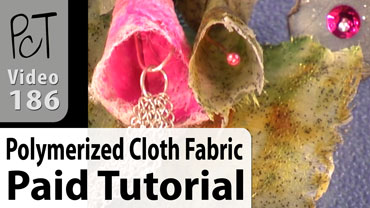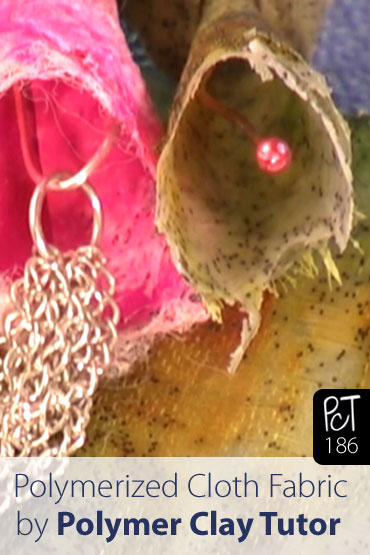Vol-032-1 Polymerized Cloth Mixed Media PcT Tutorial (Intro)
Video #186: “These new ideas always make me feel like I’m so close to a lot of like minded polymer clay artists for inspiration and motivation.”
~Elizabeth-K
More...
** This post is an introduction to one of our paid tutorials.
The concept of handcrafted Art Cloth is quite popular these days, in the Mixed Media, Fiber Arts, Jewelry Making and Quilting communities. So I figured why not add to the creative possibilities and come up with an art cloth made with polymer clay? And as a result, my Polymerized Cloth idea was born!
I actually came up with a version of this almost a year ago, fooling around with some cloth and liquid clay. But it was only recently that I finally got everything ready to be able to show you guys.
Now as it turns out, at the same time I was experimenting with this technique, another polymer clay artist by the name of Susan O’Neill was also creating something similar. She uses liquid clay and gauze to make beautiful jewelry bangles. It’s like the Universe sometimes throws a bunch of ideas out to the world to see who is ready to catch them. Susan and I must have been on the same wavelength when that happened :-)
“Art frees the mind to play in the right side of the brain where the magic of humanity lives and you can find that so much is possible.” ~Melinda-H
“This site is so amazing. These new ideas always make me feel like I’m so close to a lot of like minded polymer clay artists for inspiration and motivation.” ~Elizabeth-K
Although the basis of my idea is similar to Susan’s, what I will show you is quite different and of course has my own Polymer Clay Tutor spin on it.
I can see huge creative options for this simple technique, for use in many Mixed Media and Jewelry Making applications as well as in other arts and hobbies such as scrapbooking, quilting, sewing and a variety of other crafts.
“What a great medium we use! All this beautiful jewelry, notebooks, hair accessories, etc. And that’s just a small sampling of what can be made. I love that you can use items from other crafts with polymer.” ~Phaedrakat
“
What an amazing idea! Thank you very much!
Isabelle J
“
This is soooo easy! And fun! We have too many dryer sheets! I find them everywhere!! They will come out of your pant legs, towels, in the sheets! I may find them 'fun' now! And the Fabric Rose… cool!
Catalina L
“
Cindy... something definitely fresh and fun-looking! Great way to start the year with some new techniques.
Lupe M
Transcript coming soon...
Transcript coming soon...
Our goal is to translate these videos into as many languages as possible. If you are interested in helping with this initiative, then please do contact us and we will figure out a way to make it worth your while :)
Shareable Images



Want to chat about today’s post? That’s what the comment section below is for. Scroll Down… We’d love to hear from you!
Or... if you would like to request a topic for a future post, here is the link to do that… PcT Suggestion Box


How do I remove the two part resin that I got from Michaels some time ago. I think I tried it before I bought the UV resin. The pieces are good so I was wondering if I can save them by removing the resin??
Hi Cherie, that could be a tough one. I haven’t tried it, but maybe acetone will work? Try Googling ‘removing resin’ and see if anything comes up. Now you have me curious!
I know that tarn-x (available at Walmart and many big box stores) works fairly well on removing uv resin spills but I am not sure how well it would work on two part resins. My source was Gera Scott Chandler’s blog from a few years ago. I see Cindy was commenting then as we were all on the uv resin bandwagon at that time.
Hi Cherie! Your problem triggered my curiosity so I googled “removing resin” and found a couple of methods you might wish to try.
Never have done this myself, but can sure see with bubbles and whatnot, why you might want to strip it off and try another finishing method, or reapply the same finish.
Wikihow gives three methods, heat with acetone, freezing, and application of chemicals
westsystem.com/ss/clean-up-removing advises heat, scraping then sanding
ehow.co.uk/how_7273416_dissolve-epoxy-resin.html uses paint thinner but then gives the tip: “If you are unable to dissolve the epoxy, gently sand it away with medium grit sandpaper.”
Since wet sanding is already part of our finishing repertoire, think that’s the method I would try first, wearing a mask, goggles and gloves.
Freezing kind of intrigues me since polymer clay bends when well baked, and if you used canned air or the freezer to chill the epoxy layer then bent the piece, the resin might just crack and be able to be peeled or chipped off.
Certainly wish you the best of luck, and hope you can save your hard work.
Another interesting source: tedpella.com/technote_html/Reworking_Cured_Epoxy.pdf
Hi Cindy – it is so fantastic to have this encyclopedia of information at our fingertips! I check on your videos time and time again.
Today I was wondering if the fabric used on your ‘Polymerized Cloth’ tute could be denim? On the video you talk about the fabric needing to be fairly open weave. I’ve seen an increasing interest in e.g. pendants made with ‘denim’ plus another regular clay. I’d love to try my hand at this and wondered if you have any tips for working with denim fabric?
Thank you Cindy and Doug!
Marion
Hi Marion, denim should work for this technique because it is quite absorbent. It may take quite a bit more liquid to soak in and a little more coaxing to really get it into the fibers, but it should work. Try it on a small sample first though, just in case. I’d love to see what you end up making!
Thanks Cindy. Yes, I will try that and hope to send you a photo of my effort. How do I do that?
Marion
Looking forward to seeing them Marion! You can post your photos at the Facebook Members Gallery Page
Ammonia is what I use….face mask isn’t a bad investment either.
Can see all sorts of shapes. Did anyone master a morning glory? Origami?
You may be right, I’m at work right now, I’ll look when I get home tonight and post an answer.
This doesn’t really answer Terry’s question (I haven’t worked with UV resin I’m afraid) but I thought I’d mention it here in case it’s useful to anyone else.
2-part epoxy resin works fine over liquid Fimo, and Future. Since I started using resin, I’ve noticed that some of my older flat pieces that I covered with liquid Fimo didn’t look as good, so I experimented and found that a layer of resin over the top really improved them, gave them more strength and much more shine. And it “sticks” and doesn’t come off.
@Silverleaf: Thank for the info. Ya never know what will work til you try it ! Now when something with Future looks sad- I’ll zap it with resin :D
@pattw: Future was a floor finish before we co-opped it for our claying, if the resin won’t stay on the future, it could be removed, like you had to strip the future off a floor after so many coats. I don’t remember what it was you were supposed to use, but it can be removed if necessary.
@Ken H: I think you’re supposed to use ammonia to remove Future – if I remember the label on my bottle correctly.
Hi Terry,
Yes I have used the UV resin on the polymerized cloth once, some time ago and there was no problem. You are probably on the right track with the dryer sheet if that’s what she’s using.
Or it could be that the cloth she used was so porous that some of the UV resin soaked through and wasn’t able to cure properly. It’s not a problem with the liquid clay or the inks since I have used the UV resin on the liquid clay version of the faux opals many times with success.
I suppose there is always a chance she didn’t bake her piece hot enough and there is some sort of contamination there, though I’m thinking not.
It’s funny, I have these kinds of conversions with Donna and Doug Sheppard from PYMII as well. Some customer is experimenting and has a strange problem. It’s kind of cool how many neat things you can make if you just try it out. Doesn’t always work, but it’s fun to try.
Hopefully my answer helped. If you have any more questions, let me know.
~Cindy
Hello Cindy,
Have you tried the UV resin on anything made with liquid clay?
I have a customer that has made some fabric items with liquid clay and the resin is coming off with a sticky bottom. Normally this is because it’s not been cleaned but she says she cleaned it with isopropyl alcohol very good to begin with and said the clay was defiantly baked long enough.
I suspect either there is a difference in the liquid clay or the fabric
contained something incompatible with the epoxy. I am waiting for more information but I am guessing maybe she used a dryer sheet and it leached out some of it’s chemicals into the clay.
Just wondering if you have tried this?
Thanks!